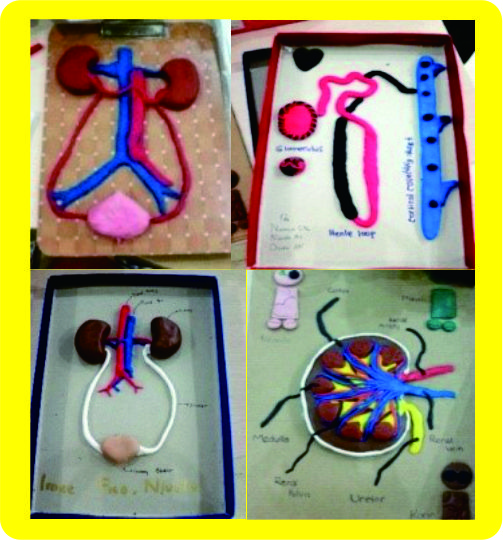
The Role of Visuospatial Representation to Improve Student’s Conceptual Mastery based on Gender in Learning Human Urinary System
Abstract
Study of this research investigates the role of visuospatial representation using Wimba model to improve student’s conceptual mastery based on gender in learning Human Urinary System. The method used in this research was experimental research with matching pretest-posttest comparison group design. The sample was taken based on gender classes consisting of boys class (n=21) and girls class (n=9) in one of Bilingual School in Bandung. The quantitative data of this research was investigated through the objective test, while the supportive qualitative data gathered through Likert-Scale. The conceptual mastery of both classes measured based on Bloom’s taxonomy cognitive domain through an objective test. Data processing was done by independent sample t-test. The result of this research shows that there are significant differences in conceptual mastery improvement between girl class and boy class by using visuospatial representation as a model. The research indicates that girl class is outperformed in conceptual mastery almost in each cognitive domain than boy class, and girl class also shows more positive responses toward learning using visuospatial representation than boy class.
Full Text:
Download PDFReferences
Anderson, G., & Arsenault, N. (2005). Fundamentals of educational research. London: Routledge.
Anderson & Krathwohl. (2001). A Taxonomy for Learning, Teaching, and Assessing: a Revision of Bloom’s Taxonomy of Educational Objective. New York: Longman Publishing.
Ausuble, P. D. (1963) The Psychology of Meaningful Verbal Learning. New York: Grune & Stratton.
Bätz, K., Wittler, S., & Wilde, M. (2010). Differences between boys and girls in extracurricular learning settings. International Journal of Environmental & Science Education, 5(1), 51-64.
Benbow, C. P., & Stanley, J. C. (1983). Sex differences in mathematical reasoning ability: More facts. Science, 222(4627), 1029-1031.
Buckley, B. C. (2000). Interactive multimedia and model-based learning in biology. International Journal of Science Education, 22(9), 895 – 935.
Campbell, N. A., Reece, J. B., & Mitchell, L. G. (2010). Biology, Concept and Connection, 9th Edition. San Fransisco: Pearson Education.
Chandler, P., & Sweller, J. (1991). Cognitive load theory and the format of instruction. Cognition and instruction, 8(4), 293-332.
Chuang, S. C. (2008). Students’ Perception of Constructivist Internet Learning Environments by a Physics Virtual Laboratory: The Gap Between Ideal and Reality and Gender Differences. Journal of Cyber Physicology Behaviour.11, (2), 150-156.
Fraenkel, J. R., Wallen, N. E., & Hyun, H. H. (1993). How to design and evaluate research in education (Vol. 7). New York: McGraw-Hill.
Geary, D. C. (1996). Sexual selection and sex differences in mathematical abilities. Behavioral and brain sciences, 19(2), 229-247.
Gersmehl, P. J., & Gersmehl, C. A. (2007). Spatial thinking by young children: Neurologic evidence for early development and “educability”. Journal of Geography, 106(5), 181-191.
Gelwick, B. P. (1985). Cognitive development of women. in N. J. Evans (Ed.), Facilitating the development of women (29-44). San Francisco: Jossey-Bass.
Gurian, M., & Ballew, A. C. (2003). The boys and girls learn differently action guide for teachers. New Jersey: John Wiley & Sons.
Halpern, D. F., & Wright, T. M. (1996). A process-oriented model of cognitive sex differences. Learning and Individual Differences, 8(1), 3-24.
Higgins, E. T. (1991). Development of Self-regulatory and Self-evaluative Process: Cost, Benefits, and Trade-offs. Minneapolis: University of Minnesota Press.
Huang, Q., Puri, A., & Liu, Z. (2000). Multimedia search and retrieval: new concepts, system implementation, and application. IEEE transactions on circuits and systems for video technology, 10(5), 679-692.
Huk, T. (2006). Who benefits from learning with 3D models? The case of spatial ability. Journal of computer assisted learning, 22(6), 392-404.
Jones, M. G., Gardner, G., Taylor, A. R., Wiebe, E., & Forrester, J. (2011). Conceptualizing magnification and scale: The roles of spatial visualization and logical thinking. Research in Science Education, 41(3), 357-368.
Kolb, D. A. (1984). Experiential Learning, Experience as a Source of Learning and Development. Englewood Cliffs NJ: Prentice-Hall.
Lazaer, D. (2004). Higher-Order Thinking the Multiple Intelligences Way. Zephyr Press: Chicago.
Lu, F. M., Eliceiri, K. W., Squirrell, J. M., White, J. G., & Stewart, J. (2008). Student learning of early embryonic development via the utilization of research resources from the nematode Caenorhabditis elegans. CBE—Life Sciences Education, 7(1), 64-73.
Maitland, S. B. (2009). Learning to Teach Ninth Edition. New York: McGraw-Hill.
National Research Council (2006). Learning to think spatially: GIS as a support system in the K-12 curriculum. Washington, DC: National Academies.
Ormrod, J. (2008). Educational psychology: Developing learners. Upper Saddle River, NJ: Prentice Hall.
Perveen, N., & Bhutta, S. M. (2012). Enhancing content knowledge of in-service science teachers through model and modeling. Journal of Research and Reflections in Education, 6(1), 61.
Pratiwi, W. N. W., Rochintaniawati, D., & Agustin, R. R. (2018). The Effect of Multiple Intelligence-Based Learning Towards Students' Concept Mastery and Interest in Matter. Journal of Science Learning, 1(2), 49-52.
Prima, E. C., Putri, A. R., & Rustaman, N. (2018). Learning solar system using PhET simulation to improve students’ understanding and motivation. Journal of Science Learning, 1(2), 60-70.
Prima, E. C., Putri, C. L., & Sudargo, F. (2017). Applying Pre and Post Role-Plays supported by Stellarium Virtual Observatory to Improve Students’ Understanding on Learning Solar System. Journal of Science Learning, 1(1), 1-7.
Putri, A. U., Rusyati, L., & Rochintaniawati, D. (2018). The Impact of Problem-Solving Model on Students’ Concept Mastery and Motivation in Learning Heat Based on Gender. Journal of Science Learning, 1(2), 71-76.
Ramadas, J. (2009). Visual and spatial modes in science learning. International Journal of Science Education, 31(3), 301-318.
Santrock, J. W. (2008) Essential of Life-Span Development. China: McGraw-Hill.
Tabrani, P. (2009). Bahasa Rupa. Bandung: Kelir Publisher.
Thompson, E. (2010). Mind in life: Biology, phenomenology, and the sciences of mind. Cambridge: Harvard University Press.
DOI: https://doi.org/10.17509/jsl.v1i3.11790
Refbacks
- There are currently no refbacks.
Copyright (c) 2018 Journal of Science Learning


Jl. Dr. Setiabudhi 229 Bandung 40154, West Java, Indonesia











